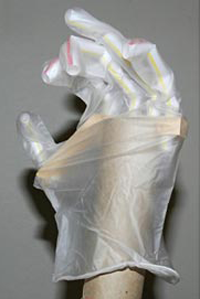Grasping with Straws: A Robotic Hand
A new Project Idea from Science Buddies challenges student engineers to design an articulated hand—from ordinary drinking straws. Proving that diving into the robotics scene for a science fair project doesn't require expensive hi-tech equipment, the project invites students to go DIY with the engineering design process. What can a robotic hand do? You decide!

Following the steps of the Engineering Design Process, students can blueprint and design a robotic hand using inexpensive straws as the primary building material—and "wiring" the hand with thread. The size, shape, and configuration of the hand depend on the ways in which the hand will be used. What kind of hand do you envision?
Olympic Athlete Uses Carbon-fiber Legs
Oscar Pistorius will be running alongside other athletes in the 2012 Olympics in London. Unlike other Olympic athletes, Pistorius has two artificial legs. A double amputee since he was a child, Pistorius, part of the South African team, will run using two "Cheetah Flex-Foot blades," each weighing in at about a pound.
These "blades" don't look exactly like lower legs and feet, but they have been carefully designed to enable the same kind of movement and control as natural legs and feet. The hand you might design in the "Grasping with Straws" project might not look exactly like a natural hand, but you may find that mirroring some of the anatomical structure of the human hand is a good place to start as you brainstorm for your project!
When you look beyond questions about the "brain" (or intelligence) of a robot and think instead of the functionality of a robot's "parts," the hand becomes a critical element in a robot's anatomy. In order to accomplish specific tasks, a robot will probably need a well-designed hand, one that can move, bend, articulate, gesture, and grasp efficiently. Without a good hand, a robot might not be worth its weight in materials, regardless of how sophisticated its artificial intelligence programming. For example, while the intelligence that allows Ruby to solve the Rubik's Cube in just under 11 seconds (still a few seconds slower than the fastest human) involves some impressive optical scanning and puzzle-solving algorithms, without the pair of robotic hands, Ruby couldn't show off her skills with the cube! That the hands are able to manipulate the cube so quickly and efficiently is a tribute to the engineering design. (See Ruby in action.)
A First Finger
For students interested in robotics and engineering, creating a robotic hand can be an exciting venture that blends physiology and design as part of the process of building a hand that can perform certain functions. A robot's anatomy doesn't have to mirror human anatomy, however, which is where things get even more creative and interesting. But by better understanding the way a human hand works, how the fingers bend, and how the "wiring" goes, you will have a better sense of how you might modify or improve upon hand design with a robotic model. A lot depends on what you want your robotic hand to do. What tasks do you want your hand to manage? What kind of hand will enable the completion of those tasks successfully? How many fingers would the hand need? How big should the hand be? How would the fingers be sized in relation to each other?
The "Grasping with Straws: Make a Robot Hand Using Drinking Straws" project, part of a new Science Buddies Robotics area that will be launched this fall, lets student engineers tackle the challenge of designing a robotic hand. This project isn't mechanized or electronic, and there are no fancy or expensive materials required. Instead, the project guides students in using the anatomy of the human hand as a starting point for building a robotic hand using straws, the kind you find in fast food restaurants!
Following steps of the Engineering Design Process, students will need to first determine what kind of robotic hand they want to make and why. What will the hand do? In order to do those tasks, what requirements are there for the hand? Answering these questions will help students develop a blueprint for the project that will help guide them through development, testing, and refining the robotic model they make. The "Grasping with Straws" project walks students through one approach to creating a single "finger" with a straw, thread, and some form of "washer" that can be used to manipulate the finger, similar to the way a marionette works. In a robotic hand with multiple joints, the string-based tendons allow bending and refined articulation and movement. This kind of precision and attention to detail—specifically to detail that supports the ultimate goal and function of the robotic part—is key in working on robotics projects.
After creating a finger, you can repeat the process to make multiple fingers—and group them as a "hand." Once you've created a "hand," you can experiment with pinching, grasping, lifting, and other movements in which multiple fingers work together. As you think about your design goals and what kind of hand you might create, think about all the different hand styles shown in the movies. Check out a copy of Robots or another popular robot film and make notes about the different kinds of hands you see. What kinds of features might be especially cool? If you've ever used a toy robot "claw" to grab things, you might have some immediate ideas about what kind of hand you might build—and ways to improve the design!
This Science Buddies Project Idea was developed with support of Symantec Corporation. Symantec Corporation also sponsors Science Buddies Project Ideas in Computer Science.
Categories:
You Might Also Enjoy These Related Posts:
- 2025 Nobel Science Connections and Projects for K-12 Students
- Chemical Reactions and Spice - STEM Projects for National Chemistry Week 2025
- 24 Halloween Science Projects and Experiments! - Halloween STEM
- Hispanic Scientists and Engineers - Hispanic Heritage Month
- New Environmental Science and Sustainability Projects for Student STEM
- 13 Boat Science and Submarine Science Projects and STEM Experiments
- Red, White, and Blue with Wearables and Soft Circuits - 4th of July STEM Activity
- Explore Artificial Intelligence and Machine Learning with Student AI Projects









